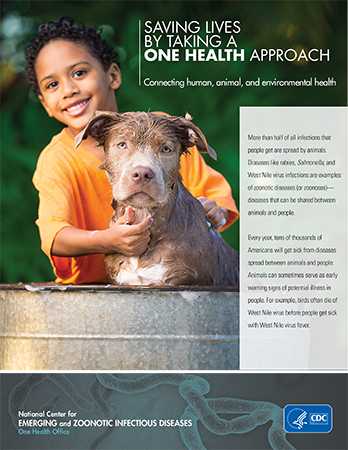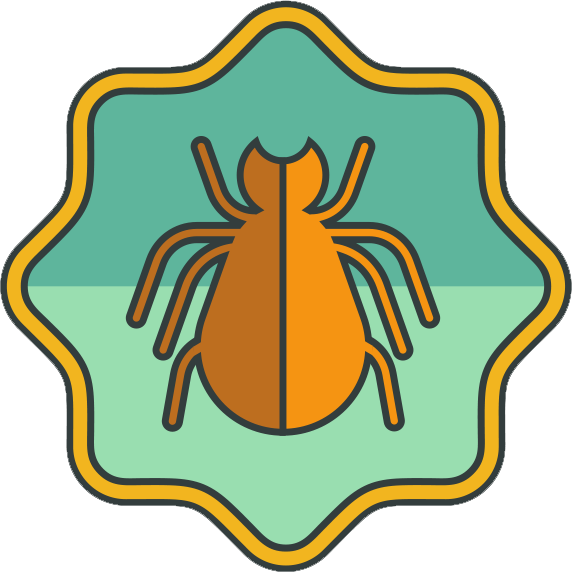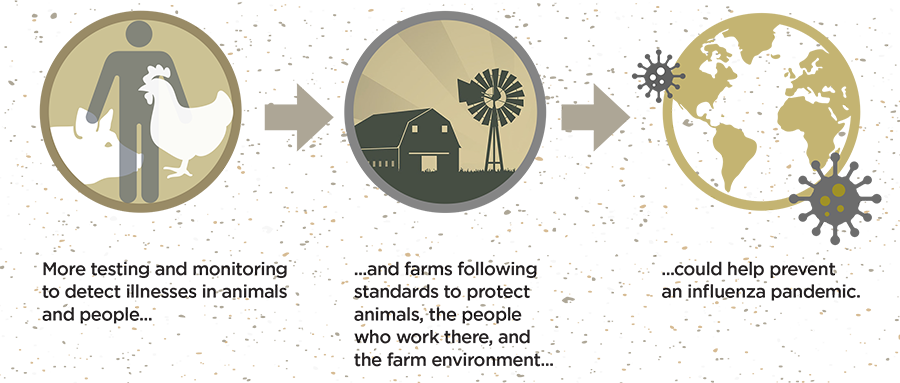Saving Lives By Taking A One Health Approach

Print Version [PDF – 4 pages]
Connecting human, animal, and environmental health
More than half of all infections that people get are spread by animals. Diseases like rabies, Salmonella, and West Nile virus infections are examples of zoonotic diseases (or zoonoses)—diseases that can be shared between animals and people.
Every year, tens of thousands of Americans will get sick from diseases spread between animals and people. Animals can sometimes serve as early warning signs of potential illness in people. For example, birds often die of West Nile virus before people get sick with West Nile virus fever.
CDC’s One Health Office recognizes that the health of people is connected to the health of animals and our shared environment. A One Health approach encourages collaborative efforts of many experts (like disease detectives, laboratorians, physicians, and veterinarians) working across human, animal, and environmental health to improve the health of people and animals, including pets, livestock, and wildlife.
Human, Animal, and Environmental Health are Linked

Cows graze next to a lettuce field. Cows can carry E. coli but still look healthy.

E. coli from cow manure in the nearby farm can contaminate the lettuce field.

People eat contaminated lettuce and can become infected with E. coli. Serious illness or sometimes death can result.
Our Charge
CDC’s One Health Office works in the United States and around the world to protect the health of humans, animals, and the environment.

What The One Health Office Is Doing In The U.S.
- Working with multiple partners to educate rural youth in agricultural organizations like 4-H and the Future Farmers of America about preventing the spread of diseases shared between people and animals like zoonotic influenza viruses. These newly formed One Health teams have reached thousands of young people and their families in states across rural America.
- One important outcome was the rapid response to an outbreak of flu in people who had attended agricultural fairs in Ohio and Michigan. These new One Health teams helped pinpoint the source of the illness—infected swine exhibited at the fairs.
- Responding to outbreaks and public health emergencies, such as examining the risk of Ebola and Zika viruses to pets and other animals.
- Protecting Americans by preventing diseases they can get from their pets like Salmonella infection and rat bite fever. Due to an increasing number of outbreaks, the One Health Office is leading the Zoonoses Education Coalition. This public-private partnership is developing evidence-based recommendations to prevent diseases for pet owners, breeders, and stores.
- These recommendations were used during an outbreak of Seoul virus that was spread to people by pet rats.
- The One Health Office shares tips about how to stay healthy while enjoying pets on CDC’s Healthy Pets, Healthy People website.

Each year around the world, it is estimated that zoonoses (diseases shared between people and animals) cause 2.5 billion cases of sickness and 2.7 million deaths
What The One Health Office Is Doing Around The World
Diseases can spread around the world very quickly, so it’s important for CDC’s One Health Office to work closely with other countries to build strong partnerships with human, animal, and environmental health organizations. This protects Americans from illnesses that cross borders and affect travelers.
Globally, the One Health Office is taking a strategic, targeted approach to control and prevent infectious diseases. For example, experts from the One Health Office lead One Health Zoonotic Disease Prioritization Workshops so that countries can focus limited resources on their top zoonotic diseases of greatest national concern. Zoonotic diseases commonly prioritized include viral hemorrhagic fevers such as Ebola virus and Rift Valley fever, zoonotic influenza viruses, rabies, and anthrax.
- Workshop participants include a wide-ranging group of people who protect health—of people, animals, or the environment—and they identify a country’s top 5 diseases to target for One Health collaborations.
- Workshop participants develop strategies to tackle the newly prioritized zoonotic diseases. For example, having a dog vaccination campaign for rabies can lead to fewer human rabies deaths in a country.
- Prioritizing diseases means countries can more efficiently build lab capacity, conduct disease surveillance, plan outbreak response and preparedness activities, and create disease prevention strategies to reduce illness and death in people and animals.

One Health In Action: A Success Story

In the southwestern U.S. and Mexico, brown dog ticks can carry a germ that causes Rocky Mountain spotted fever in people and dogs.

In Arizona, free-roaming dogs were spreading infected ticks. Many people got sick and some died from Rocky Mountain spotted fever.

Public health and animal health officials used long-lasting tick collars on dogs, regular pesticide applications around homes, community education, and provided free spay and neuter clinics for dogs.

After only 4 months, 99% of dogs were tick-free in the community. The number of people who had Rocky Mountain spotted fever went down in the community.
Looking ahead: How a One Health Approach Better Prepares Us

ONE HEALTH means a collaborative, multisectoral, and trans-disciplinary approach—working at the local, regional, national, and global levels—with the goal of achieving optimal health outcomes recognizing the interconnection between people, animals, plants, and their shared environment.
Print Version [PDF – 4 pages]
- Page last reviewed: August 18, 2017
- Page last updated: August 18, 2017
- Content source:


 ShareCompartir
ShareCompartir